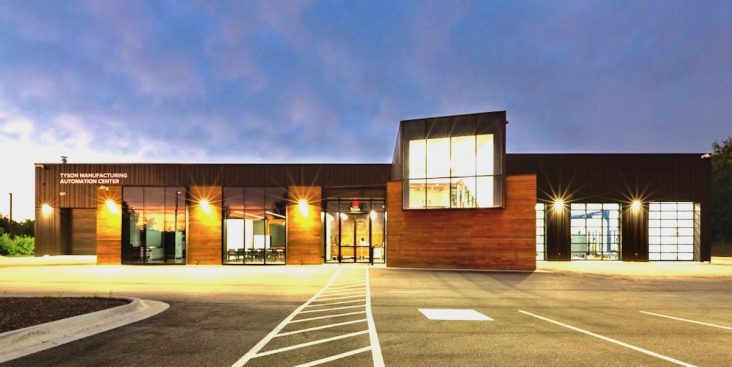Tyson Manufacturing Automation Center finding solutions to labor issues
by October 19, 2020 12:20 pm 2,517 views

Tyson Foods has invested $500 million in technology innovations over the past three years, including the Tyson Manufacturing Automation Center (TMAC) in downtown Springdale which has been part of the company’s operations amid the COVID-19 pandemic.
The Springdale-based meat giant was hit hard with COVID-19 cases among several of its processing plants, such as the Berry Street poultry plant in Springdale, and large beef and pork processing facilities in Iowa. As consumer demand soared this spring, it was hard for retailers to keep poultry, beef and pork in stock as plant absenteeism was high in certain markets. Tyson also had several processing plants that had to close for an average of 10 days for deep cleaning and sanitization and they reopened following the protocol and guidelines from health officials and the U.S. Centers for Disease Control and Prevention.
Tyson turned to its manufacturing automation center to develop, test and rapidly deploy thermal scanning cameras across the entire enterprise in just 7 weeks.
“TMAC dropped everything and within one week we had scanners in a plant and testing team members,” said Derek Burleson, a corporate spokesman for Tyson Foods.
Thermal scanning cameras made it possible to accurately and quickly test employees’ temperature as they entered the building. In some plants, the cameras also tested employees while working on the processing line during the day.
Burleson said the TMAC is helping the company solve its most difficult challenges. The two-story, 26,000 square-foot facility has four areas including a machine vision tech lab, a lab that simulates the food production environment for extensive testing before machines go to the plant. The center also contains classrooms for training and providing hands-on automation and robotics technology.
While the TMAC was already in the works when CEO Dean Banks became president in 2019, Banks has said he sees opportunities to provide technology expansion and continue Tyson’s automation goals. Some of the things the center is working on now include solving labor issues – and possibly reducing the labor needed – with machine technology.
Burleson said Tyson is developing an automated deboning system designed to handle some of the roughly 39 million chickens the company processes each week. An example is a water-jet cutting system capable of carving up chicken breasts more precisely than can be accomplished by manual labor. He said many Tyson chicken plants are now using the system to develop new products they could not make using human labor. Tyson said its efforts to create and implement the “robot butchers” was accelerated by the COVID-19 pandemic and will likely be even more important as the pandemic continues.
Burleson also said 3D vision technology is being used to count products as it travels on the processing line to ensure more accurate accounting. This process was formerly done manually.
Robotics is deemed one of the most promising solutions for increased productivity in manufacturing as plants look to solve labor shortages and Tyson is no exception. Burleson said Tyson is committed to developing standards for safe and reliable automation. Banks has said more automation will not take jobs away from humans on any large scale any time soon. He said when jobs become automated the employee would be reassigned. He said many times the automation is for jobs that are hard, strenuous and have the most employee turnover.
Tyson said it’s also collaborating with trusted partners of artificial intelligence, machine vision and IoT solutions.
